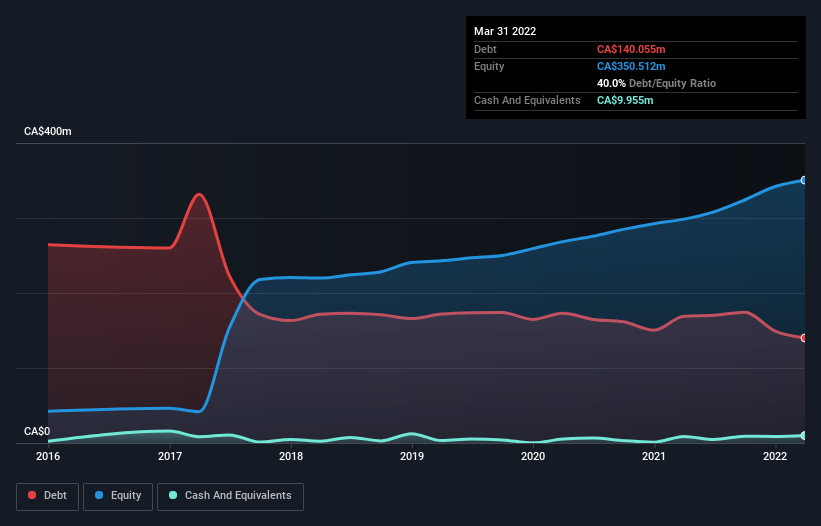- Canada
- /
- Personal Products
- /
- TSX:JWEL
Here's Why Jamieson Wellness (TSE:JWEL) Can Manage Its Debt Responsibly

Warren Buffett famously said, 'Volatility is far from synonymous with risk.' It's only natural to consider a company's balance sheet when you examine how risky it is, since debt is often involved when a business collapses. We can see that Jamieson Wellness Inc. (TSE:JWEL) does use debt in its business. But the more important question is: how much risk is that debt creating?
When Is Debt Dangerous?
Debt and other liabilities become risky for a business when it cannot easily fulfill those obligations, either with free cash flow or by raising capital at an attractive price. In the worst case scenario, a company can go bankrupt if it cannot pay its creditors. While that is not too common, we often do see indebted companies permanently diluting shareholders because lenders force them to raise capital at a distressed price. Having said that, the most common situation is where a company manages its debt reasonably well - and to its own advantage. When we examine debt levels, we first consider both cash and debt levels, together.
Check out our latest analysis for Jamieson Wellness
What Is Jamieson Wellness's Debt?
As you can see below, Jamieson Wellness had CA$140.1m of debt at March 2022, down from CA$169.1m a year prior. However, because it has a cash reserve of CA$9.96m, its net debt is less, at about CA$130.1m.

A Look At Jamieson Wellness' Liabilities
According to the last reported balance sheet, Jamieson Wellness had liabilities of CA$84.1m due within 12 months, and liabilities of CA$218.7m due beyond 12 months. Offsetting these obligations, it had cash of CA$9.96m as well as receivables valued at CA$90.2m due within 12 months. So its liabilities total CA$202.6m more than the combination of its cash and short-term receivables.
Since publicly traded Jamieson Wellness shares are worth a total of CA$1.54b, it seems unlikely that this level of liabilities would be a major threat. Having said that, it's clear that we should continue to monitor its balance sheet, lest it change for the worse.
We measure a company's debt load relative to its earnings power by looking at its net debt divided by its earnings before interest, tax, depreciation, and amortization (EBITDA) and by calculating how easily its earnings before interest and tax (EBIT) cover its interest expense (interest cover). The advantage of this approach is that we take into account both the absolute quantum of debt (with net debt to EBITDA) and the actual interest expenses associated with that debt (with its interest cover ratio).
Jamieson Wellness has a low net debt to EBITDA ratio of only 1.4. And its EBIT easily covers its interest expense, being 15.0 times the size. So we're pretty relaxed about its super-conservative use of debt. And we also note warmly that Jamieson Wellness grew its EBIT by 17% last year, making its debt load easier to handle. When analysing debt levels, the balance sheet is the obvious place to start. But it is future earnings, more than anything, that will determine Jamieson Wellness's ability to maintain a healthy balance sheet going forward. So if you want to see what the professionals think, you might find this free report on analyst profit forecasts to be interesting.
Finally, a company can only pay off debt with cold hard cash, not accounting profits. So we clearly need to look at whether that EBIT is leading to corresponding free cash flow. Looking at the most recent three years, Jamieson Wellness recorded free cash flow of 39% of its EBIT, which is weaker than we'd expect. That's not great, when it comes to paying down debt.
Our View
Happily, Jamieson Wellness's impressive interest cover implies it has the upper hand on its debt. And that's just the beginning of the good news since its EBIT growth rate is also very heartening. Looking at all the aforementioned factors together, it strikes us that Jamieson Wellness can handle its debt fairly comfortably. On the plus side, this leverage can boost shareholder returns, but the potential downside is more risk of loss, so it's worth monitoring the balance sheet. When analysing debt levels, the balance sheet is the obvious place to start. But ultimately, every company can contain risks that exist outside of the balance sheet. Be aware that Jamieson Wellness is showing 1 warning sign in our investment analysis , you should know about...
When all is said and done, sometimes its easier to focus on companies that don't even need debt. Readers can access a list of growth stocks with zero net debt 100% free, right now.
New: Manage All Your Stock Portfolios in One Place
We've created the ultimate portfolio companion for stock investors, and it's free.
• Connect an unlimited number of Portfolios and see your total in one currency
• Be alerted to new Warning Signs or Risks via email or mobile
• Track the Fair Value of your stocks
Have feedback on this article? Concerned about the content? Get in touch with us directly. Alternatively, email editorial-team (at) simplywallst.com.
This article by Simply Wall St is general in nature. We provide commentary based on historical data and analyst forecasts only using an unbiased methodology and our articles are not intended to be financial advice. It does not constitute a recommendation to buy or sell any stock, and does not take account of your objectives, or your financial situation. We aim to bring you long-term focused analysis driven by fundamental data. Note that our analysis may not factor in the latest price-sensitive company announcements or qualitative material. Simply Wall St has no position in any stocks mentioned.
About TSX:JWEL
Jamieson Wellness
Develops, manufactures, distributes, markets, and sells the natural health products for human in Canada, the United States, China, and internationally.
Solid track record and good value.
Similar Companies
Market Insights
Community Narratives




